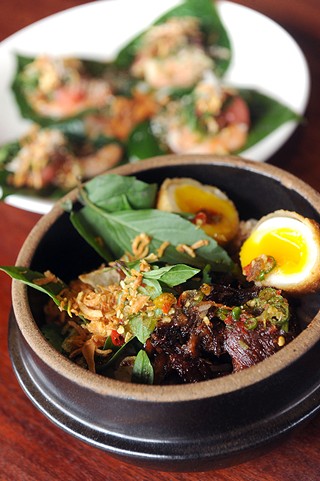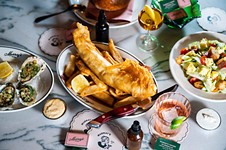Thai-Brids
Blurring the lines of Thai cuisine
By Melanie Haupt, Fri., Feb. 6, 2015
Go to any Thai restaurant in Austin – or anywhere, really – and you'll see the same primary ingredients featured with comforting consistency: Fish sauce. Rice. Chiles. Coconut milk. Galangal. Lemongrass. Basil. They're all deployed in the interest of developing complex flavors that keep four or five tastes in balance: sweet, sour, salty, bitter, spicy. These are staples used in a cuisine that dates back to the 14th century. And yet some folks are finding ways to use them that, surprisingly, help to broaden the scope of Thai food.
There are words we should not use when discussing food innovations these days. "Fusion" is far too tired. "Authenticity" comes with way too much baggage for polite company. Worse, these words are empty husks of language absent real meaning anymore. "Mash-up" is too DJ culture. "Modern" is overused and pretentious. So how, then, do we describe practitioners of an ancient cuisine that test the borders, dancing an electrifying pas de deux with ingredients and techniques from other foodways while still maintaining the bones of home? In this globalized world rife with hybrid identities, perhaps it's useful to think of the kind of tinkering chefs do in terms of seeing how far the rubber band will stretch. How far can one push the definition of a cuisine?
Take rice. It's a blank slate (mostly). Not nutritious, but not not nutritious. It just ... is. But this staple crop of Thailand is a foundational ingredient in the traditional cuisine. While it usually rests alongside blazing hot and sour curries, it also gets dressed up and mixed with herbs and vegetables in southern Thailand's khao yam (rice salad), or served steeped in coconut milk with banana or mango. But at Kin & Comfort, chefs Ek Timrerk and Bonnie Wright take the wallflower and turn it into the base of their panang mac and cheese: rice noodles bathed in cheese sauce and topped with a rich beef curry. It's a Southern child's comfort food of fat and carbohydrates, reinterpreted and married to the tang and heat of galangal and chilies.
Down the road in San Antonio, chef Quealy Watson at Hot Joy takes a classic red tomato curry redolent of fragrant Thai basil, makrut lime, coconut milk, and fish sauce, and adds tripe for a distinctive South Texas flair. (Offal is not alien to Thai cuisine, but the choice here is both transparent and deliberate.) Sway here in Austin gives a similar Texan goose to an already-hybrid dish, the prawn miange. Betel leaves aren't a common ingredient in stateside Thai restaurants, but Australian cooks specializing in Thai cuisine use them regularly. Sway's prawn miange is an homage to that Aussie interpretation, with the traditional notes of fish sauce and tamarind present alongside a Texan twist of grapefruit.
Here's why these dishes aren't "fusion," nor need we worry about whether they are "authentic": Thai cuisine itself is rooted in a long history of borrowing. For example, northern Thai cuisine is informed not only by its geography and climate, but also by its proximity to Myanmar, Laos, and China. Southern Thailand is home to most of the country's Muslim population, as well as the country's coconut plantations; both of these factors have a profound influence on that region's cuisine. Contemporary Thai food owes a debt to Japanese, Vietnamese, Indian, and Chinese cuisines; there are even "American-style" fried rice dishes made with ketchup, hot dogs, and bacon – an extension of how someone envisioned the way Americans eat. There is no authenticity: There is only bricolage, play, experimentation.
It makes sense, then, that chefs in Austin and its surrounds would borrow from the regional practices and ingredients that shape their identities here, poking at the boundaries that demarcate a cuisine and building upon it. For them, the most important ingredient is imagination.









